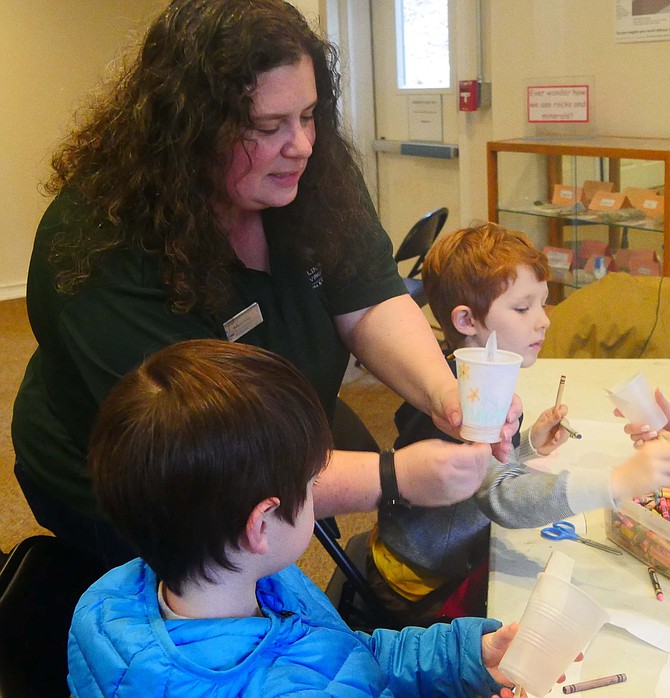Barbara (Bobbi) Farley, the Park Naturalist, on loan from Long Branch Nature Center, teaches Grumpy Groundhog class.
This didn’t stop the Grumpy Groundhog class at Gulf Branch Nature Center and Park Thursday afternoon. They made groundhog burrows out of paper cups and then took a hike through the park to identify the habitat, food and where the groundhog’s predators would be waiting.
“So who knows another name for a groundhog? Barbara (Bobbi) Farley, the park naturalist, asks the group of 6-10 year olds arranged around two rectangular tables. Ben asks, “You mean the scientific name? I only know a few of those.” Others volunteered woodchuck, marmot and beaver.
Farley explains a groundhog burrows underground and then comes to the surface. She explains the class will have a craft today where they can create the inside of the paper cup as the burrow and the outside as the landscape. Farley pulls out her phone and holds up a picture. “It looks like this. But you are the artist so it’s your choice. You can create anything you want.”
After liberal use of scotch tape, the small picture of a groundhog gets attached to a Popsicle stick and inserted into a hole in the bottom of a cup. Eyes focus as each of the groundhogs pops out of the hole and over the top of the cup.
“Now I’ve got some cool things to tell you about groundhogs before we take our hike.” Farley holds up the pelt of a groundhog. “No, you can touch but not put your mouth on it … no kissing.” A small boy demonstrates an air kiss.
She continues, “What makes a mammal a rodent is these teeth. These are plastic replicas but the real teeth are small but very strong. They never stop growing, like your fingernails.
“This is a real chewed-on log by a beaver,” she says holding up a mostly missing tree truck. “By chewing on things they keep their teeth sharp and short.”
Farley explains groundhogs hibernate or go to sleep. “They store up body fat and sleep through the winter. Their heart rate is very slow. When you go to sleep everything slows down. You aren’t using energy. Let’s see. Now everyone put your hand on your heart and feel your heartbeat.”
“I can’t feel my heart.”
“Me neither.”
After assisting with an anatomy lesson Farley says, “Now let’s do jumping jacks; everyone do 30. Now feel your heartbeat. See how fast it is. That’s what happens when a groundhog wakes up.”
The groundhog has definitely predicted winter in Arlington. It is cold but the kids run out the door with jackets half zipped and hats askew to chase down their own real life groundhog hiding behind a tree.
